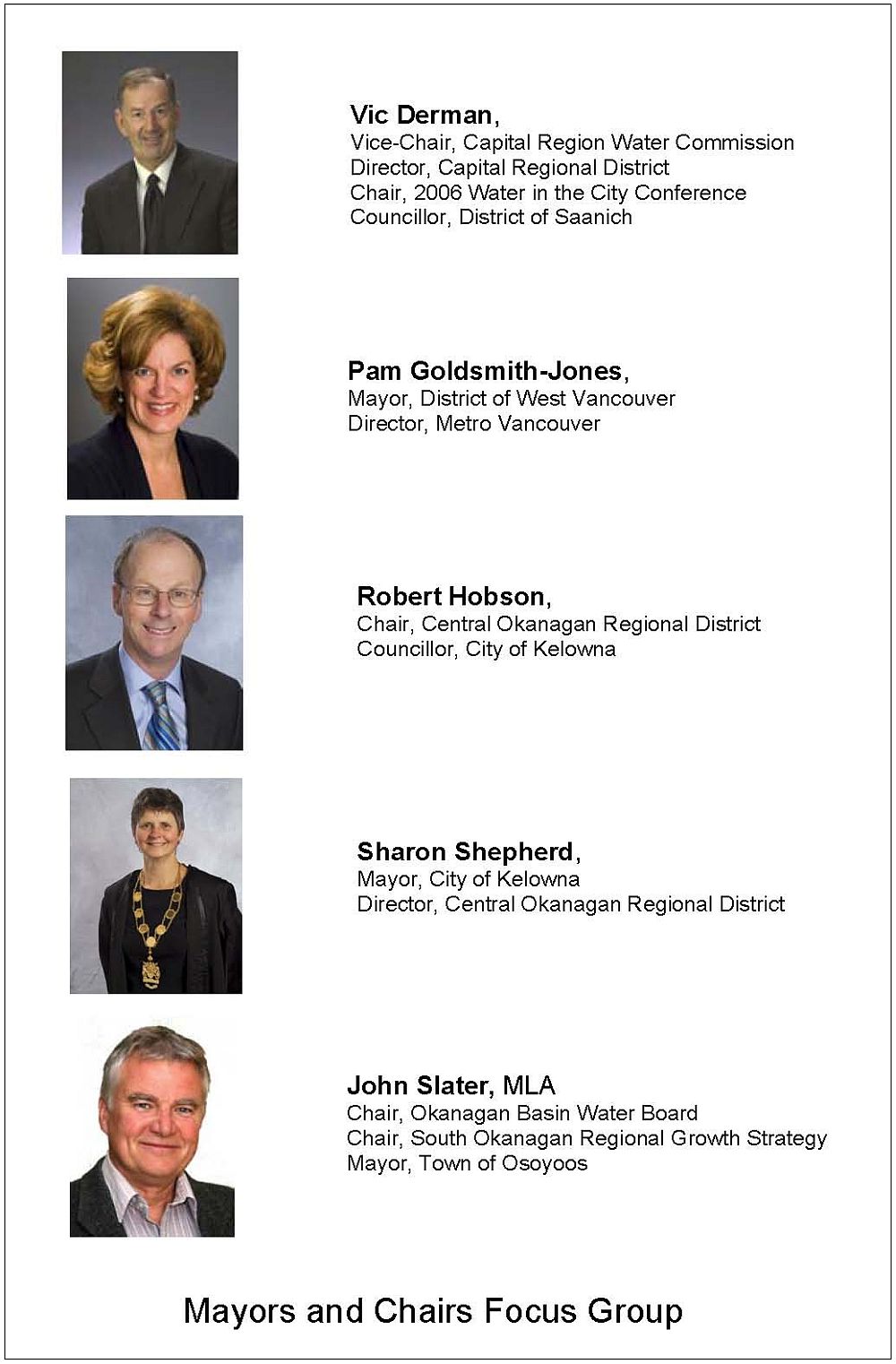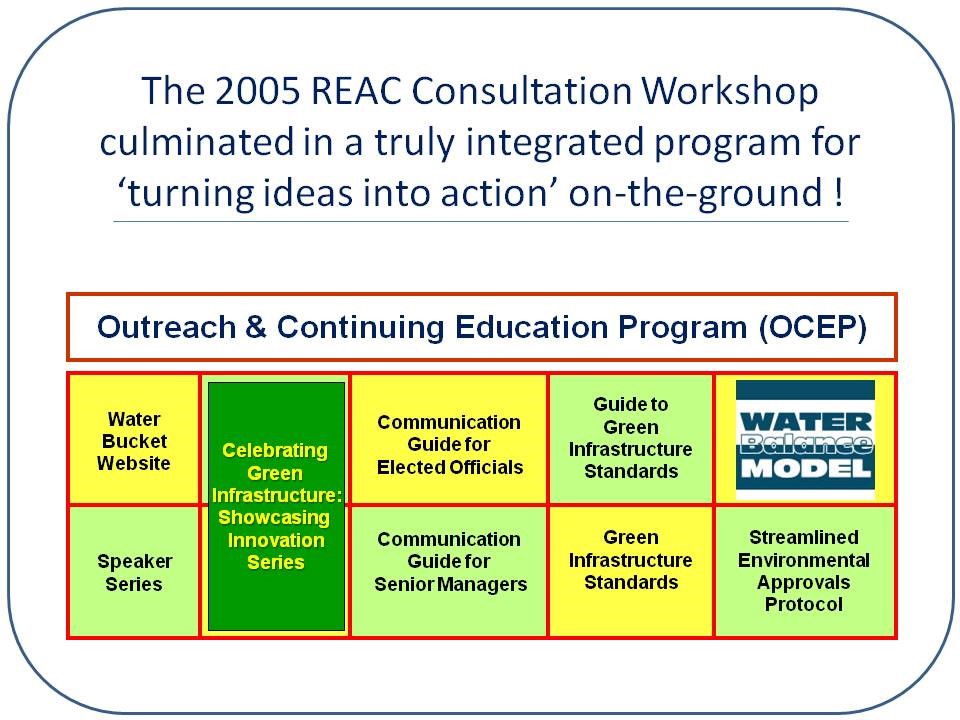FLASHBACK TO 2006: “At the end of the day, we literally tore up our work plan. It was clear that practitioners did not need another guidance document that would go on a shelf. Rather, they needed to network and learn from each other,” stated Ray Fung, Chair, when the Green Infrastructure Partnership released a report on conversations with a mayors and chairs focus group (September 2006)
Note to Reader:
In May 2005, and under the umbrella of the Water Sustainability Action Plan, the Green Infrastructure Partnership organized a consultation workshop with local governments in the Metro Vancouver region. The workshop solicited feedback and input on the development of communication guides for elected officials and senior managers, respectively.
The 2005 workshop set in motion a chain of events. One outcome was a decision to have one-on-one conversations with an ‘ad hoc mayors and chairs focus group’ that had representation from three regions. By listening to what elected officials had to say, this provided an informed basis for framing how to move forward with changes in the way we develop land and use water in British Columbia.
The article below is extracted from Chapter 5 of Beyond the Guidebook 2010: Implementing a New Culture for Urban Watershed Protection and Restoration in British Columbia. The extract provides relevant context for introducing the report, released in 2006, that distilled what was learned by interviewing mayors and chairs. The process informed the evolution of the Water Sustainability Action Plan for British Columbia.
Chapter 5 in Beyond the Guidebook 2010 described the elements of the partnership-based ‘Outreach and Continuing Education Program’ (OCEP), implemented under the umbrella of the Water Sustainability Action Plan, that promoted a ‘water-centric’ approach to community planning and development.

Green Infrastructure Partnership
Formation of the Green Infrastructure Partnership in 2003 was a milestone development. It broadened the ‘design with nature’ coalition beyond government. It also set in motion the next evolution of the component Outreach and Continuing Education Program led by the Green Infrastructure Partnership under the Action Plan umbrella.
To Learn More:

2005 Metro Vancouver Consultation Workshop
“Going into the 2005 Metro Vancouver Consultation Workshop with the Regional Engineers Advisory Committee (REAC), the Green Infrastructure Partnership vision was to develop a Model Subdivision Bylaw and green infrastructure standards. The workshop proved to be a revelation for all those who participated,” stated Ray Fung, Chair (2008-2011).
 “As we went around the table, the stories came out as to what Metro Vancouver municipalities were doing. A common refrain was: ‘We didn’t know you were doing that!’ The energy in the room just kept building and building.
“As we went around the table, the stories came out as to what Metro Vancouver municipalities were doing. A common refrain was: ‘We didn’t know you were doing that!’ The energy in the room just kept building and building.
“At the end of the day, we literally tore up our work plan. It was clear that practitioners did not need another guidance document that would go on a shelf. Rather, they needed to network and learn from each other.
“The OCEP emphasis shifted from ‘informing and educating’ to ‘showcasing and sharing’. We witnessed the motivational power of celebrating successes. We also recognized the need to get the story out about the leadership being shown by local government.”
Workshop Outcomes
The Focus Group process opened the door to exploratory meetings with the Metro Vancouver political leadership. In October 2006, for example, the steering committee for the Green Infrastructure Partnership met with the Sustainable Region Initiative Task Force to seek support for a Mayors Forum on Green Infrastructure.
To Learn More:

Ad Hoc Mayors & Chairs Focus Group
“Another pivotal outcome of the 2005 workshop was our decision to consult with a number of Mayors and Chairs from the Okanagan, Metro Vancouver and Vancouver Island. We formed an ad hoc focus group to help us,” continued Ray Fung.
“We had it in our minds to write a Communication Guide for Elected Officials. We saw this filling a gap because what has been lacking is this – written information on green infrastructure from the perspective of elected officials, for elected officials. So we conducted one-on-one interviews.”
“A distinguishing feature of the focus group was that everyone had thought about how to achieve environmental, economic and social objectives through a community’s infrastructure choices.”
Conversation Template

Key Messages
The one-on-one interviews yielded consistent insights. A unifying theme was the issue of leading and implementing change; also, emphasis was placed on the importance of mobilizing political will to achieve settlement change in balance with ecology. Key messages as synthesized in the 2006 summary report are:
- Time is of the essence.
- To create a legacy, there must first be a shared vision.
- Trumpet small successes.
- Encourage innovation.
- Federal/provincial infrastructure programs will ultimately drive changes to infrastructure standards and practices.
- Leaders can create the ‘buzz’, the interest and the energy to imagine what the future could look like and then make it happen.
- The position of mayor provides a leader with the credibility and authority necessary to translate a community vision into action.
- Mayoral collaboration will be a powerful force for change when there is a shared regional vision for the Built Environment.
“What we learned was not unexpected. Rather, it was more a case of validation. The findings and key messages are standing the test of time,” concluded Ray Fung.
TO LEARN MORE:
Download Water – Choosing Sustainability for Life and Livelihoods: Convening for Action in British Columbia to read about what was learned in conversations with members of the Ad Hoc Mayors and Chairs Focus Group, and the insights that they provided.

.

